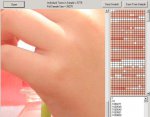Can anyone help me, I have a problem that im not sure how to solve. I am writing a program for changing skin tones in images by remapping the colours. I have the colour extraction working fine in order to create a swatch, but my problem is getting the swatch in order of the lightest colour first. This i want to do so that I can create a scale or histogram from it.
Colours in the swatch are written in order of argb from -1. The fromArgb colours are obviously not in order like this as the swatch shows white (or light yellow) further down the grid followed by skin colours again.
If you have any ideas how to do this it would be greatly appreciated. If you have a sample or can point me to one that would be fantastic.
Many thanks
Colours in the swatch are written in order of argb from -1. The fromArgb colours are obviously not in order like this as the swatch shows white (or light yellow) further down the grid followed by skin colours again.
If you have any ideas how to do this it would be greatly appreciated. If you have a sample or can point me to one that would be fantastic.
Many thanks
Attachments
Last edited:


